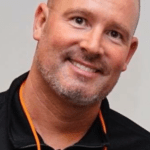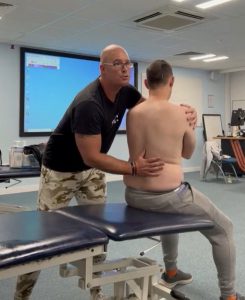Sports massage therapy may be your new best friend as a personal trainer looking to stand out from the crowd. Paul Edmondson explains.
The combination of proficiency and certification in both personal training and sports massage therapy may be the next evolution of fitness trainer!
Up until now, very few have combined the two skillsets, most choosing to be either a trainer or a manual therapist. What I believe will spawn very soon (after this great article maybe?!) is the new ‘manual trainer’ – a trainer who knows movement and exercise like no other professional, who also has hands-on skills to assess/treat and specify needed requirements posed by their clients.
Now, I’m preaching to the converted where movement and exercise are concerned, so I’m pretty sure I don’t need to ‘sell’ that to this forum, but why should you (the trainer) upskill and add sports massage to your portfolio of offerings?
What can massage offer both you and your clients?
- Better movement
A primary objective for any trainer is to assist their clients to ‘move better’, which we have the ability to do through visual screening assessments and gaining verbal feedback as trainers. However, by also adding the therapist’s skillset, we have the additional assessment ability to ‘feel’ where/what needs work via our hands kinaesthetically.
You see, movement, stretch and exercise at a trainer’s level really only addresses the client on a macro level (meaning integrated muscles/tissues as parts of a chain). For years, we have been talking about the need for whole-body movements, training, assessments, etc. and with good reason because it’s ‘functional’ (the whole is greater than the sum of its parts).
Somewhere along the way, though, we have lost sight of the fact that, in the whole, there are ONLY the parts. If the parts do not display optimal function, the whole (body) is compromised and the equilibrium is challenged. Sometimes – many times – it behoves us to go ‘local’ and address the micro level of tissue, as the micro affects the macro function as discussed above.
By using your hands as a therapist, you are able to detect sense through ‘feeling’ – your fingers have specialised sensory organs that, when you know how to ‘listen’ to them and what to look for, become powerful in your assessment armour. This takes time but, as you can appreciate, it takes your level of understanding up a notch and helps you to create better strategies and solutions for your clients.
There are many reasons why movement capacity may diminish in a body: there could be neurological tension (the nervous system) having ‘trust’ issues with an area (lack of strength, stability and/or mobility can do this); there could be scar tissue laid down; there could be early degenerative changes in a joint that, if left will become osteoarthritic. With all these, health as well as movement are hindered.
- Faster recovery
You can use massage as a means to recover quicker – hydration (rehydration of muscles) will decrease the seizing up/soreness effect post training that can occur. Plus, it can aid restful sleep and homeostasis post training with suppression of cortisol, and boost melatonin/serotonin, which will promote healthy sleep, and secretion of growth factors (anabolic hormones that ramp up during restful sleep). This means better recovery and aesthetic gain in/around training for your client.
- Mobility
It can be used to assist intra-/inter-muscular mobility, allowing individual fibres, as well as bundles of fibres, to be stretched, pulled and decongested via multi-dimensional techniques that the therapist’s hands can apply to the tissues.
- Workout preparation
A massage can also have pre-workout effects – the use of vibration/tapotement techniques can be utilised to stimulate nerve endings (Pacinian corpuscles) that live in the skin and are ‘turned on’ by vibration. Because these nerve endings stimulate and supply muscle fibres, this can be used to awaken or recruit more motor units within specific regions pre exercise to impact on performance (strength output) and stability (more muscles contracting around joints to maintain better/optimal position), which in turn has defensive benefits that stand up against potential injury during exercise.
- Variation
Adding massage to your skillset adds variation and more avenues to go down with your work options, as well as different environments to work in. Changing environments is fun and can defend against feeling like you’re in the same environment doing the same thing for 30-40 hours a week!
- Monetary gain
More often, therapeutic interventions such as massage have a higher income rate area to area compared to PT rates (on average).
- Increased knowledge
Your appreciation for the body and how you can help people becomes greater by having a good understanding of both fields.
- Referral network
Reaching out to more clients and having more healthcare knowledge and insight means that you could/should be dealing with GPs, physios, chiropractors, etc. This will serve your business greatly with numbers and cases, and also raise your profile in health and fitness across your region.
Hey… and did you know we have insurance to cover Sports Massage too? Go check it out right now – we even have combined cover of Public Liability and Sports Massage ✔️
Explore our sports massage therapist insurance and get covered today.
Author Bio

Paul Edmondson is a dedicated leader within the fitness industry, having worked with, and for some of the leading pioneers and biggest brands in the world both nationally and globally. Paul has presented in 24 countries, over 5 continents on behalf of Gray Institute, ViPR, TRX, Anatomy Trains, Trigger Point, SKLZ, institute of Motion and at the IDEA World conference. His thought-provoking sessions are designed to bridge the gap between the traditional and new sciences to better equip trainers to serve their unique and individual clients. Paul takes pride in delivering complex content in a simplified and application specific manner that is perfect for trainers wanting to learn more, and is determined to drive forward those he works with to help them become “better versions of themselves”








